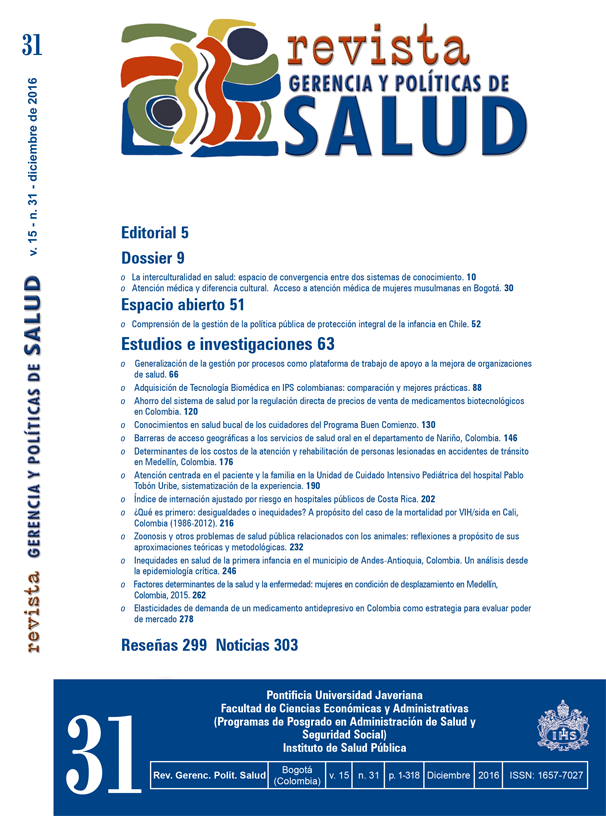Abstract
We analyzed in this research article the process of technology acquisition in Colombian health service provider institutions (IPS). For this purpose we applied a business assessment methodology called benchmarking in six different IPS of the Antioquia department (both in the public and private sectors). This allowed us to identify the main ways to acquire biomedical technology; the prioritization of technological needs; the methods used by hospitals to assess medical equipment; the sources for the identification of needs; the legal and technical requirements requested at the moment of purchase; and also the amount of searches performed regarding national and international alerts in databases related to the devices. In this way, we developed a comparative and competitive referencing work as a management tool promoting characterization and the inclusion of the possible practical improvements carried out by clinics and hospitals across the country..
médicos. Ginebra: Organización Mundial de la Salud; 2012.
2. Cruz AM. Gestión tecnológica hospitalaria. Un enfoque sistémico. Bogotá: Editorial Universidad
del Rosario; 2010.
3. Valencia J, Manrique R. Evaluación de tecnologías en salud. CES Medicina. 2004; 18(2):81-86.
4. Ayres M. Evaluación económica de tecnologías médicas. Revista de Antiguos Alumnos del IEEM. 2006; 9(13):79-87.
5. Farzipoor Saen R. Technology selection in the presence of imprecise data, weight restrictions, and ondiscretionary factors. The International Journal of Advanced Manufacturing Technology.
2009; 41(7-8):827-838.
6. Carvajal M, Ruiz CG. Evaluación técnica y clínica de tecnología biomédica en procesos de adquisición:
Un enfoque en evaluación de tecnologías en salud. Revista Ingeniería Biomédica. 2008; 2(4):34-45.
7. Organización Mundial de la Salud. Formulación de políticas sobre dispositivos médicos. Ginebra: Organización Mundial de la Salud; 2012.
8. Organización Mundial de la Salud. Evaluación de las necesidades de dispositivos médicos. Ginebra:
Organización Mundial de la Salud; 2012.
9. Otálvaro EH. Modelo de evaluación y gestión de equipamiento. Documento 5088. Bogotá: Ministerio
de Protección Social; 2007.
10. Franco R, Vilcahuamán L. Ingeniería clínica y su relación con la epidemiología. Revista Peruana de Epidemiología. 2010; 14(1):6-16.
11. Ranking de los mejores hospitales y clínicas de América Latina [Internet]. Disponible en: http://
rankings.americaeconomia.com/mejores-clinicashospitales-2014/ranking/
12. Ríos RM. Seguimiento, medición, análisis y mejora en los sistemas de gestión. Enfoque bajo indicadores
de gestión y balanced scorecard. Bogotá: Icontec; 2009.
13. Salazar KJ. Contribución metodológica para la evaluación de la tecnología biomédica en la Clínica
Universitaria Bolivariana con fines de acreditación según los estándares de la Joint Commission International
[tesis de maestría]. Medellín: Universidad Nacional de Colombia; 2015.
14. Malhotra NK. Investigación de mercados. Quinta edición. México: Pearson Educación; 2008.
15. Biogestión, Cigraf. Determinación de la capacidad de integración empresarial y la evaluación tecnológica y su implementación en el Centro de Desarrollo Tecnológico para la Competitividad de la Industria de la Comunicación Gráfica Cigraf. Bogotá: Universidad Nacional de Colombia; 2006.
16. Kotler P, Armstrong G. Marketing. Versión para Latinoamérica. Decimoprimera edición. México:
Pearson Educación; 2007.
17. Parada L, Taborda A, Chicaíza L. Evaluación económica de tecnología sanitaria y toma de decisiones
en salud. Coyuntura Económica: Investigación Económica y Social. 2013; XLIII(2):81-95.
18. Gutiérrez C, Giedion U, Muñoz A, Ávila A. Series de notas técnicas sobre procesos de priorización de
salud. Procesos de priorización explícita en salud: un enfoque sistémico. Bogotá: Banco Interamericano
de Desarrollo; 2012.
19. Rodríguez ED. Ingeniería clínica. La Habana, Cuba: Instituto Superior Politécnico José Antonio Echeverría. Centro de Bioingeniería Cebio; 2003.
20. González B. La incorporación de nuevas tecnologías en el Sistema Nacional de Salud. Costeefectividad
y presiones sobre el gasto sanitario. Presupuesto y Gasto Público. 2007; 49:87-105.
21. Molina T. Ingeniería clínica para no ingenieros: adquisición de equipos médicos. Revista Ingeniería
Biomédica. 2007; 2:40-47.
22. Rosales A, González R, Cantillo E, Esquivel L, Rodríguez M. Metodología para la evaluación de tecnologías de salud en el Seguro Social de Costa Rica, 2014.
23. Schonfeld C. La evaluación de tecnologías en salud como herramienta para la mejora de la gestión del
laboratorio. Acta Bioquímica Clínica Latinoamericana. 2013; 47(1): 121-143.
24. Naranjo D, Ruiz D. Aplicación del benchmarking en la gestión de la cadena de aprovisionamiento sanitaria: efectos sobre el coste y la calidad de las compras. Gaceta Sanitaria. 2015; 29(2):118-122.
25. Hernández AM, Ruiz LF, Duque CM, Álzate JI, García JH. Modelo para evaluación de tecnología biomédica y su aplicación en la adquisición de equipos para un hospital público colombiano. En Folgueras J, coordinador. IFMBE Proceedings 33. La Habana, 2011. p. 444-7.
26. Camacho J. Modelo de gestión de tecnología biomédica para una institución de salud de tercer nivel
[tesis de maestría]. Medellín: Instituto Tecnológico Metropolitano; 2015.
27. González A, Collazos M, García LJ, Ladino JA, Cano A, González SA. Análisis del estado actual de la ingeniería clínica en las instituciones hospitalarias de Cali. Revista Ingeniería Biomédica. 2015; 9(18): 73-80.
Copyright notice
The Journal Management and Health Policies is registered under the Creative Commons Recognition 4.0 International license. Therefore, this work can be reproduced, distributed and publicly communicated in digital format, provided that the name of the authors and the Pontificia Universidad Javeriana are recognized. It is allowed to quote, adapt, transform, autoarchive, republish and create from the material, for any purpose (including commercial), provided that authorship is properly acknowledged, a link to the original work is provided and if changes have been mad. The Pontificia Universidad Javeriana does not retain the rights over published works and the contents are the exclusive responsibility of the authors, who preserve their moral, intellectual, privacy and publicity rights.
The endorsement of the intervention of the work (revision, style correction, translation, layout) and its subsequent disclosure is granted through a license to use and not through a transfer of rights, which means that the journal and the Pontificia Universidad Javeriana disclaims any liability that may arise from ethical misconduct on the part of the authors. As a result of the protection provided by the license for use, the journal is not obliged to publish retractions or modify the information already published, unless the erratum arises from the process of editorial management. The publication of contents in this magazine does not represent royalties for taxpayers.


